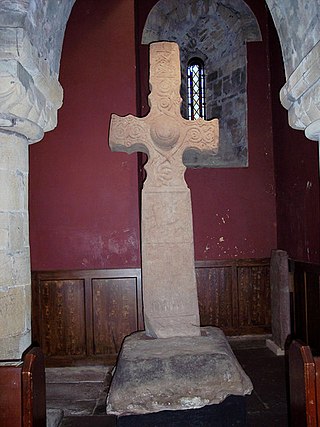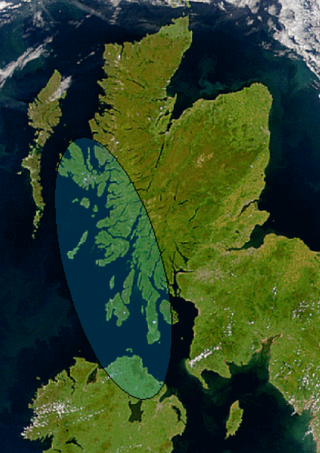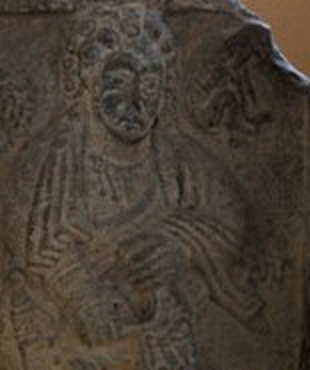Conall Cernach is a hero of the Ulaid in the Ulster Cycle of Irish mythology. He had a crooked neck and is said to have always slept with the head of a Connachtman under his knee. His epithet is normally translated as "victorious" or "triumphant", although it is an obscure word, and some texts struggle to explain it. Alternative meanings include "angular, having corners", "swollen", or "possessing a dish or receptacle". The original form of the name "Conall" in Ogham inscriptions was Cunavalas.
Conchobarmac Nessa is the king of Ulster in the Ulster Cycle of Irish mythology. He rules from Emain Macha. He is usually said to be the son of the High King Fachtna Fáthach, although in some stories his father is the druid Cathbad, and he is usually known by his matronymic, mac Nessa: his mother is Ness, daughter of Eochaid Sálbuide, King of Ulster.

Causantín or Constantín mac Fergusa was king of the Picts, in modern Scotland, from 789 until 820. He was until the Victorian era sometimes counted as Constantine I of Scotland; the title is now generally given to Causantín mac Cináeda. He is credited with having founded the church at Dunkeld which later received relics of St Columba from Iona.
Fiannamail ua Dúnchado was a king of Dál Riata at the end of the 7th century. Little can be said with certainty other than the recording of his death in 700AD, where he is listed as having been slain alongside Flann mac Cind-fâelad of the Cianachta Glenn Geimin in present-day County Londonderry, Northern Ireland.

Áedán mac Gabráin, also written as Aedan, was a king of Dál Riata from c. 574 until c. 609 AD. The kingdom of Dál Riata was situated in modern Argyll and Bute, Scotland, and parts of County Antrim, Ireland. Genealogies record that Áedán was a son of Gabrán mac Domangairt.
Conaire Mór, son of Eterscél, was, according to medieval Irish legend and historical tradition, a High King of Ireland. His mother was Mess Búachalla, who was either the daughter of Eochu Feidlech and Étaín, or of Eochu Airem and his daughter by Étaín. In the Old Irish saga Togail Bruidne Dá Derga he is conceived when his mother is visited by Nemglan who flies in her skylight in the form of a bird, and is brought up as Eterscél's son.
Mongfind is a figure from Irish legend. She is said to have been the wife, of apparent Munster origins, of the legendary High King Eochaid Mugmedón and mother of his eldest three sons, Brión, Ailill and Fiachrae, ancestors of the historical Connachta. She was Eochaid's first wife; his second wife, Cairenn, gave birth to Niall of the Nine Hostages. Several tales depict Mongfind as an adversary of Niall. Mongfind is also said to have been the sister of Crimthann mac Fidaig, King of Munster and the next High King of Ireland, whom she is said to have killed with poison in a bid to make her son king. She drank the poisoned drink to convince Crimthann, and died soon after at Samhain.
Cúscraid known by the epithet Mend Macha, is a son of Conchobar mac Nessa in the Ulster Cycle of Irish mythology.

The Eóganachta were an Irish dynasty centred on Cashel which dominated southern Ireland from the 6/7th to the 10th centuries, and following that, in a restricted form, the Kingdom of Desmond, and its offshoot Carbery, to the late 16th century. By tradition the dynasty was founded by Conall Corc but named after his ancestor Éogan, the firstborn son of the semi-mythological 3rd-century king Ailill Aulom. This dynastic clan-name, for it was never in any sense a 'surname,' should more accurately be restricted to those branches of the royal house which descended from Conall Corc, who established Cashel as his royal seat in the late 5th century.
Conall mac Taidg was a king of the Picts from 785 until 789. Very little is recorded of Conall. He is mentioned twice by the Irish annals, the most reliable source for the history of northern Britain in the years around 800. He also appears in later king lists.

Colmán of Cloyne, also Colmán mac Léníne, was a monk, founder and patron of Cluain Uama, now Cloyne, County Cork, Ireland, and one of the earliest known Irish poets to write in the vernacular.
Domnall mac Caustantín is thought to have been king of Dál Riata in the early ninth century.
Conall mac Áedáin was a king in Scotland in the years around 800. It is thought that he was a king, or sub-king, in Dál Riata.
Cellach mac Máele Coba was an Irish king and is said to have been High King of Ireland.
Conall mac Máele Coba, called Conall Cóel, was an Irish king and is said to have been High King of Ireland.
Diarmait was a son of Áed Sláine. According to the Irish annals, he was High King of Ireland.
Corc mac Luigthig (340-379), also called Conall Corc, Corc of Cashel, and Corc mac Láire, is the hero of Irish language tales which form part of the origin legend of the Eóganachta, a group of kindreds which traced their descent from Conall Corc and took their name from his ancestor Éogan Mór. The early kindred they belonged to are known as the Deirgtine. He was probably a grandson of Ailill Flann Bec, and possible cousins were Dáire Cerbba and the famous Crimthann mac Fidaig. The latter is his opponent in a celebrated cycle of stories.
Events from the 7th century in Ireland.

The House of Óengus is a proposed dynasty that may have ruled as Kings of the Picts and possibly of all of northern Great Britain, for approximately a century from the 730s to the 830s AD. Their first ruler of Pictland was the great Óengus I of the Picts, who may be the figure carved into the St Andrews Sarcophagus pictured on the right.
The Cenél Conaill, or "kindred of Conall", are a branch of the Northern Uí Néill, who claim descent from Conall Gulban, son of Niall of the Nine Hostages, and allegedly the first Irish nobleman to convert to Christianity. Their kingdom was known as Tír Conaill, with their powerbase at Mag Ithe in the Finn valley, however they gradually expanded to cover what is now counties Donegal and Fermanagh. The Cenél Conaill clashed regularly with their kin the Cenél nEogain, eventually capturing the latter's original power-base of Ailech in the Inishowen peninsula—in modern-day County Donegal—by the 12th century.




